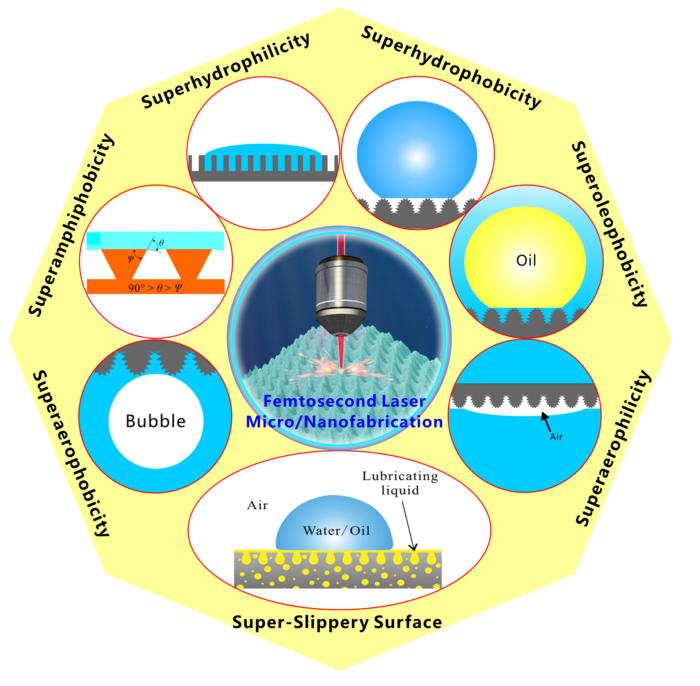Thanks to billions of years of evolution, numerous organisms in nature have displayed exceptional surface wettability. For example, the leaves of the lotus flower possess the self-cleaning function.
 Various femtosecond laser-induced extreme wettabilities. Image Credit: Ultrafast Science
Various femtosecond laser-induced extreme wettabilities. Image Credit: Ultrafast Science
Water striders are capable of walking on water. Rain does not stop butterflies from flying. The eyes of a mosquito can prevent fog. Fish cannot be polluted by oil underwater. Cacti, desert beetles and spider silk are capable of collecting water mist.
Inspired by these extreme wetting occurrences in nature, a series of super wettabilities has been accomplished based on various micro/nano-machining techniques because the material surface’s wettability mainly relies on the chemical composition and the solid surface’s microstructure.
Although the most traditional micro/nano-processing approaches can be used to obtain superwettability, these approaches are more or less bound by some intrinsic limitations, such as lack of flexibility, complex preparation steps and limitations to specific materials. It is still a massive challenge to engineer a flexible and simple tool/technique to create different superwetting microstructures on any solid substrates.
The laser is regarded as one of the paramount inventions of the 20th century. Femtosecond (10-15 s) lasers, a modern ultrashort pulsed laser, have two features of very high peak intensity and ultra-short pulse width.
In the last few years, the femtosecond laser has become a vital tool for modern-day extreme and ultra-precision manufacturing. The femtosecond laser can ablate nearly any material, creating microstructures on the material’s surface.
The femtosecond laser also is beneficial in the fine design of micro/nanostructure. Since the surface microstructure has a major effect on the wettability of solid substrates, femtosecond laser processing is employed to develop special nanoscale and microscale structures on substrate surfaces and acquire different superwettabilities. The femtosecond laser exhibits a robust ability to design and alter the wettability of materials.
Recently, Yong et al. methodically summarizes the applications and realizations of the superwettability realized by the femtosecond laser. Stimulated by nature, superwetting microstructure can be effortlessly prepared on the surface of solid materials using femtosecond laser processing.
Superhydrophilicity can be attained by developing a hierarchical microstructure on a hydrophilic substrate, which causes water to completely wet the material surface. Superhydrophobicity is a synergistic effect that occurs between surface microstructure and low-surface-energy chemistry.
To realize superhydrophobicity, it is essential to employ a femtosecond laser to directly build the hierarchical microstructures on the hydrophobic substrate or construct microstructure on the hydrophilic substrate followed by low-surface-energy alteration. Superhydrophobic materials impressively resist aqueous solutions. The re-entrant microstructure is crucial to attaining superamphiphobicity.
The superamphiphobic surfaces also possess both superoleophobicity and superhydrophobicity. In contrast to the preparation of superamphiphobic surfaces, underwater superoleophobic surfaces can be effortlessly created by producing microstructure on a hydrophilic substrate.
Both kinds of superoleophobic surfaces have a robust repellence to oily liquids and oils, but superamphiphobic materials are functional in the air while underwater superoleophobic materials are functional in the water.
Femtosecond laser-induced superhydrophilic microstructures typically display superaerophobicity, and the superhydrophobic microstructures ultra-short pulse width superaerophilicity in a water medium. The underwater superaerophobic surfaces can resist bubbles so that bubbles find it hard to stick to the material surface in water.
However, bubbles can effortlessly disperse over underwater superaerophilic surfaces and be absorbed by solid surfaces. The femtosecond laser can straightaway create porous microstructures on different solid substrates.
The lubricating fluid is additionally filled into the laser-induced pores to develop a thin lubricating layer on the surface of the solid substrate. The as-prepared slippery surfaces display superior repellence against numerous pure or composite liquids.
The emerging supermetalphobicity and superpolymphobicity are also shortly introduced. The laser-induced microstructures that repel underwater liquid metals or liquid polymers can be used to exploit and pattern polymers and liquid metals.
The exclusive surface wettability allows the femtosecond laser-processed materials to possess numerous practical applications in oil/water separation, self-cleaning, microfluidics, anti-liquids, anti-icing/fogging/snowing, antifouling, liquid patterning, drag reduction, anti-corrosion, water harvesting, manipulation of liquid droplets, lab chip, buoyancy enhancement, cell engineering, and so on.
Although the technology of femtosecond laser regulating surface wettability is still restricted by the flaw of low machining efficiency, its robust flexibility and the ability to process nearly any material are unmatched by any other micromanufacturing technology.
With more superwetting surfaces being engineered and prepared and new applications developing, this research direction certainly has a favorable future. The researchers are certain that the mass-scale, commercial application of the femtosecond laser-induced superwetting materials will soon become a reality.
Journal Reference:
Yong, J., et al. (2022) Nature-Inspired Superwettability Achieved by Femtosecond Lasers. Ultrafast Science. doi.org/10.34133/2022/9895418.